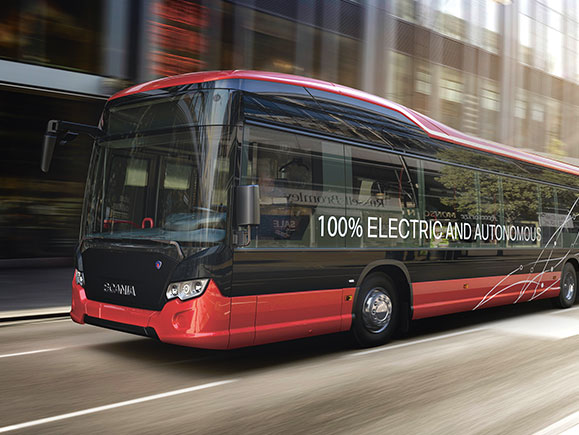Electric drive systems play a pivotal role for the TRATON GROUP in the transportation world of tomorrow. They provide the opportunity to use electricity from renewable resources directly for transportation. How quickly this technology becomes established in the market depends primarily on the versatility of the vehicle.
Andreas Kammel frequently encounters preconceived notions such as this: “A heavy-duty truck is loaded to the limit of its permissible total weight of 40 tons. With the truck on the road 24/7, it covers at least 200,000 kilometers per year. To handle that workload with an electrically powered vehicle, the truck would have to pull an additional trailer with a 10-ton battery. That is simply impossible.” Kammel, who has a PhD in plasma physics, listens patiently. He then responds in a soft, yet determined voice. He explains that more than every second truck doesn’t reach its permissible total weight at all because, for example, the load capacity is limited by volume and not mass. Also, many 40-ton vehicles are not even used in conventional long-haul transportation but rather travel the same routes every day—for example to transport goods from a port or a supplier to a factory that is only 100 to 200 kilometers away. Furthermore, there are legally prescribed rest periods that the drivers must adhere to. After four and a half hours on the road at most, they are required to take a break for 45 minutes, also on long-haul routes—at least in the European Union member states.


Andreas Kammel is responsible for the TRATON GROUP’s electrification strategy.
The size of the battery is a determining factor
“All of that is relevant for electrifying heavy-duty commercial vehicles,” says Kammel, who is responsible for the TRATON GROUP’s electrification strategy. “After all, how often the battery can be charged, and thus how big it is, determines the costs and feasibility of an all-electric truck.” And only the costs of acquisition and operation allocated to the transported load count in the transportation industry. A revolutionary battery technology that is very inexpensive and even has energy densities resembling those of conventional diesel fuel is not in sight for the time being. “We probably won’t see an alternative to the lithium-ion battery that is suitable for the mass market in the next ten years,” suggests Kammel. But with the technology in the next product generation, a range of 350 kilometers can be covered, which is enough for a four-and-a-half-hour trip. The driver’s prescribed rest period can be used to quickly recharge the battery. The extra weight of the entire electric drive system, compared with the weight of a combustion engine, transmission system, and fuel tank, is between one and two tons; a handicap that has already been compensated for in Europe with a higher permissible total weight for electric trucks. According to Kammel’s estimate, technology that is currently available or will become available in the near future could be applied to a third of all areas requiring the use of heavy-duty trucks.
“Electric city buses are on the verge of an economic breakthrough. For many delivery vehicles, this is also within reach.”Andreas Kammel
Strategy & Business Opportunities, TRATON GROUP

Scania intends to trial electric and autonomous city buses in a residential area near Stockholm.
However, TRATON is still not satisfied with the status quo of battery technology. “We are taking a two-pronged approach,” explains Kammel. On the one hand, TRATON has access to fully developed cell technology and innovative technologies from the Volkswagen Group’s passenger car segment; on the other hand, Scania, through a stake in the Swedish battery specialist Northvolt, is developing its own battery cells with chemistry specifically designed for use in commercial vehicles.
The focus is on inner-city distribution and city buses
But there are still quite a few hurdles to overcome before electric vehicles can be deployed economically on long-haul runs—and that includes the appropriate charging infrastructure. The breakthrough will be much easier to achieve in inner-city distribution and especially with city buses—that is, away from the highways. The challenges in these areas are significantly more manageable, and not just because of the considerably fewer kilometers driven each day. A large percentage of buses and delivery vehicles are parked overnight anyway, allowing for sufficient time to recharge the batteries. “Since drivers have to brake a lot in city traffic, a high proportion of the energy in the fuel ends up as waste heat in the environment,” explains Kammel. “With an electric vehicle, most of the braking energy can be recovered. This considerably improves the economic efficiency of an electric vehicle.” In addition, an increasing number of municipalities are likely to close certain zones to vehicles with a combustion engine. Kammel is certain that “electric city buses are on the verge of an economic breakthrough. For many delivery vehicles, this is also within reach.”
Being fully electric doesn’t necessarily mean carrying the electricity in a battery on board. There are two other alternatives currently being looked at in the industry: generating the electricity on board in a fuel cell, or feeding it to the vehicle via an overhead line while driving. “In terms of technology, both are absolutely fascinating concepts,” affirms Kammel. In light of this, the TRATON GROUP brands are participating in several research and pilot projects. For example, Scania, together with the waste-handling company Renova and several other partners, is currently developing a refuse truck where a fuel cell not only powers propulsion, but also provides the energy for the compactor. Scania is also delivering three-axle fuel-cell distribution trucks to Asko, a Norwegian retail conglomerate, as part of a research project. And in Germany, Scania trucks with current collectors are being deployed on the country’s first e-highway south of Frankfurt am Main. “Projects like these allow us to gain technological expertise,” says Kammel—and refers back to the iron law of the transportation industry: “Despite all preconceived notions, the technologies that will ultimately prevail are those that offer the transportation operator the best economic efficiency.”


350 kilometers in range can be covered with the technology in the next product generation.




.jpg/jcr:content/Teaser-Grafik-Tiva-Sharifi-3840x2560-V1-(1).jpg
)
.jpg/jcr:content/Teaser-Grafik-Mansoureh-3840x2560-V1-(1).jpg
)


